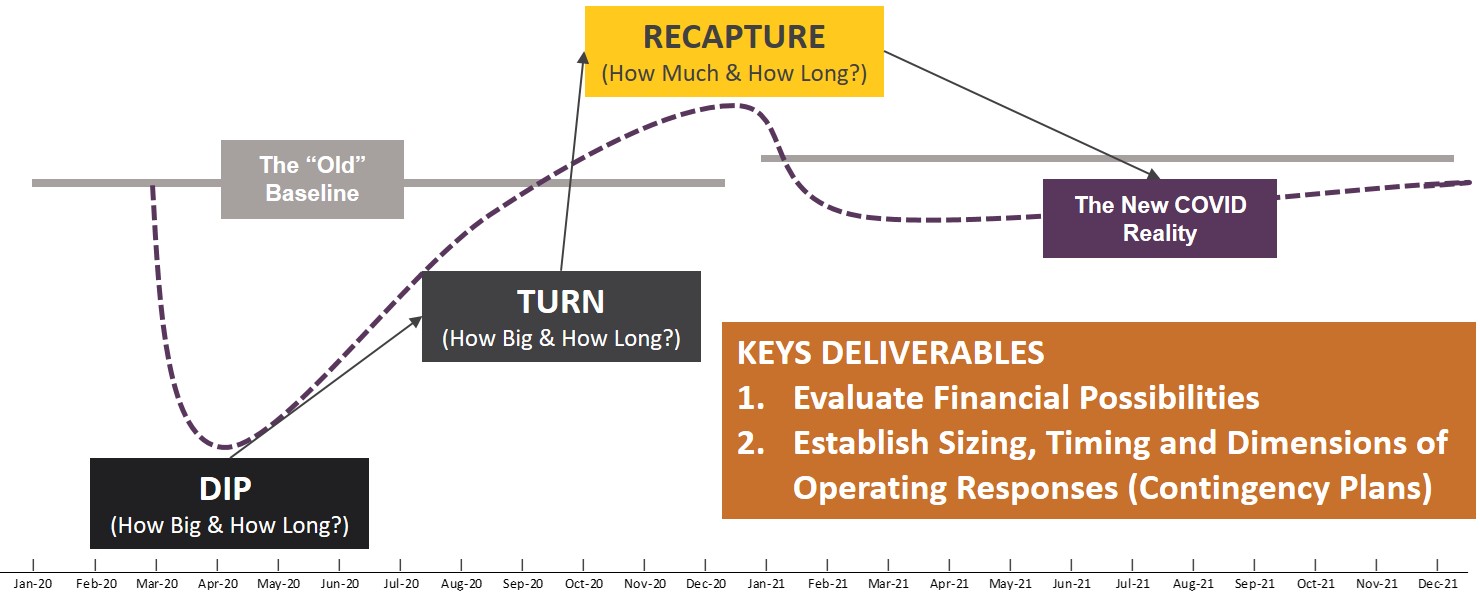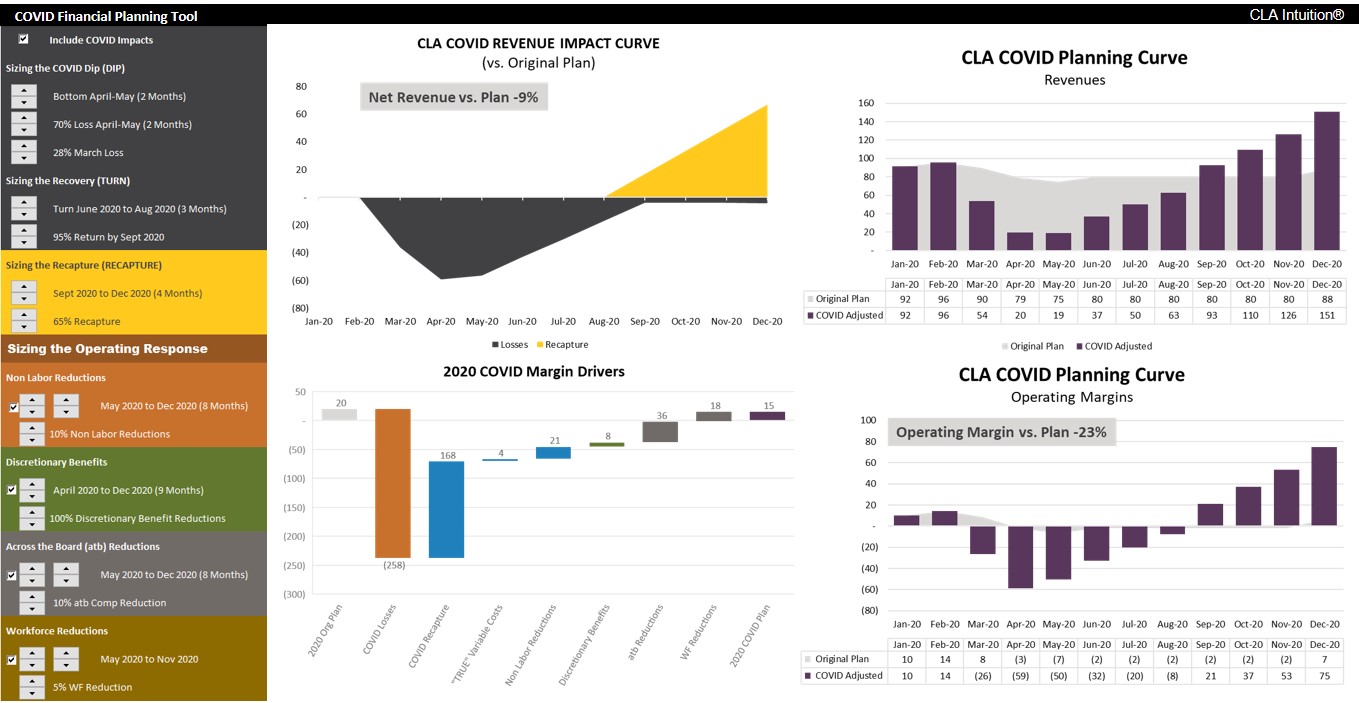
Unprecedented challenges brought by the coronavirus will have significant impact on your cash flow and operations. Apply these four strategies to help with critical ...
Thank you to all health care providers for your service to our communities. In the face of unprecedented challenges brought by the coronavirus (COVID-19), we know that you are working long hours and enduring intense stress to help ensure our safety. You are appropriately focused on standing up your incident command centers and developing plans to meet the rapidly changing needs of our communities. You are preparing your health care organizations in the event facilities are pushed to clinical capacity limits. Hard decisions, such as cancelling elective clinic and procedural services, are being made. These changes will have significant impact on your cash flow and operations.
Use predictive modeling to guide your decisions today and into the future with CLA Intuition® Financial Modeling
During any protracted period of crisis, the ability of an organization to manage cash and cash flow becomes a vital operational tool that impacts success. Clear insights into strategies impacting cash flow are critical to near-term decision making and can help you understand the potential longer-term impact on the health of your balance sheet.
There are key steps you can take now to help ensure your organization is prepared to manage the escalation of challenges associated with COVID-19, as well as prepare for the potential economic aftermath ahead.
Inventory the expense impact
New expenses incurred
Having a clear line of sight into expenses is the start of any cash or cash flow management initiative. Within this process, the easiest element to identify is new expenses incurred in order to ensure adequate response. Relative to COVID-19, expenses incurred will vary but could consist of:
- Supply and equipment costs
- Staffing costs such as overtime, agency staff, sick leave, free meals, etc.
- Additional security
- Screening of patients, such as setting up remote testing locations
These are just a few examples of the wide array of increased expenses providers are experiencing. During this time, it is critical to create not only a system to identify increased expenses, but also a structure to account for those expenses so the full magnitude can be understood.
Not only will understanding these costs inform strategy, capturing them is important for future reimbursement. Federal, state, and local agencies will require documented support of COVID-19-specific costs in order to access the grant funds that continue to roll out. Planning and establishing this system now will reduce the risk of lost reimbursement in the future.
Expenses that can be reduced, deferred, or flexed
A second, no less important, element of inventorying expenses is to create a roster of specific areas where your organization has the ability to flex and/or reduce costs. Creating this inventory will provide leadership with specific considerations on where expenses can be reduced, deferred, or flexed in order to preserve cash flow. Consider items such as:
- The cost of lost productivity in departments that have temporarily closed or reduced services
- Utilizing call pay vs. having clinical staff scheduled on site with no activity
- Encourage use of paid time off for any non-essential employees
- Cancelling any purchase orders for supplies that are not immediately necessary
These are just a few of the expense levers to consider, and there are undoubtedly more. The critical step here is to create as broad of an inventory as possible, in order to provide leadership with the financial levers that may be necessary to pull in order to guide the organization.
Quantify the lost revenue
Across the country we are hearing stories of providers cancelling services that are elective or non-emergent in nature. Specific to health systems, these are often the highest revenue producing services offered, and the impact of cancelling them and shutting down service lines will have a profound financial impact. Quantifying this impact for both the short- and long-term by service line is important to leadership from a planning standpoint, because it will provide critical information around:
- Volume that may be lost permanently to competitors
- Patient demand that has been delayed, which may create pressure on capacity after the crisis is over
- The dollar value of revenue interruption for filing of insurance claims
Again, this is far from a complete listing of the potential revenue impact a health care organization may experience. The critical takeaway is to organize these impacts so the information can be used to inform key decision makers throughout this transition and into the future.
Balance sheet health
Just as organizations are dealing with significant income statement instability, the value of investments on balance sheets has been dramatically reduced. The past several years have seen many organizations experience reduced margins, lower cash reserves, and rating/outlook downgrades. In recent years, however, the one bright spot has been the positive return on investments. In fact, for many health care organizations, these positive returns have been the foundation driving their total margin. With the spread of the pandemic and stock market volatility, balance sheets have taken a significant hit, and most likely investment returns will no longer be there to prop up total margins. Modeling the impact of a prolonged event on the balance sheet may provide leadership with key information for decisions in the short-term.
Pulling it all together and building your strategy
Once the inventory of the above items is pulled together, create a financial and operational model to help guide the strategic thinking and decision-making of C-suite executives. As mentioned previously, cash reserves and access to cash is critical during challenging time periods like we are experiencing now. Success during the management phase will demand that leadership has a clear view into the financial impact of as many known elements as possible, and a clear understanding of which levers can be pulled to help ensure your organization has access to the cash it will need to not only weather the challenge, but also be better positioned for any economic repercussions.
The modeling charts below show how COVID-19 could impact revenue streams and corresponding cash flows. In times of chaos, utilizing a model that can seamlessly illustrate the impact of changing patient volumes and various strategic responses will have on your organization’s cash flows is critical. This will help ensure leadership is as informed as possible, and help create directional unity in decision-making.
How we can help
At CLA we not only have a deep understanding of the full continuum of the health care industry, we have developed key insights and capabilities to help guide leaders and boards through difficult times such as these. We understand the challenges and pressures being placed on leaders of all heath care organizations, and the distractions impacting the strategic, operational, and financial disciplines normally in place. CLA has long been recognized as a leader supporting clients with predictive modeling through its CLA Intuition® modeling service. Our CLA Intuition® capabilities allow us to support clients in viewing the short- and long-term impacts of decisions that are being made in real time including:
- Operating expense changes
- Financial impact of lost volume
- The capacity challenges that “catching up” will cause on volume that was delayed
- The impact of operating and investment performance on the balance sheet
We stand at the ready, to lean in and help you create the path that not only helps you weather the storm, but also provides you with the necessary insights to help conquer any economic consequences. Reach out to your CLA client service leader today, and have a discussion of the challenges you are facing — we are here and ready to help.
View our COVID-19 resource page to stay up to date.


